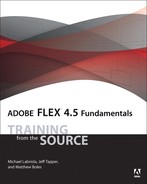Foreword
Over a decade ago, Adobe (then Macromedia) coined the term rich Internet application, or RIA, to describe the future of browser-based applications. This new breed of application supplemented existing server-based applications with an enhanced client-side user experience. As Internet users became increasingly sophisticated, demand for improved user experiences grew. At the center of this paradigm shift was Adobe Flex, a simple and light-weight framework for developing applications.
Once a novelty, Internet usage on phones and tablets has exploded. Users can now access the Internet more from mobile devices than from personal computers. As such, user demand for browser-based applications is shifting to applications installed on devices. Yet again, the Flex framework can be found leading the charge. With the release of the Flex 4.5 SDK, Flex applications can now be deployed as native applications to Android, Apple iOS, and Blackberry devices. With this book, you hold in your hands all the knowledge and best practices necessary to deliver killer applications for not just one of the leading mobile platforms...but all of them!
Adobe Flex is composed of a number of elements. It uses a declarative markup language called MXML to help structure your application and ActionScript, a highly productive scripting language, to glue all the pieces together. The framework also has built-in support for CSS and a simple but comprehensive skinning model. These complimentary languages will probably look familiar to those with HTML and JavaScript experience. In addition to the languages that power Flex, the framework provides layout containers, form controls, validators, effects, state management frameworks, a multipurpose animation library, and much more to help you rapidly build the next generation of web applications.
Of course, what good is a slick interface if you can’t connect it to live data and services? Fortunately, Flex offers a multitude of ways to connect to nearly any backend service, whether it is raw XML over HTTP, SOAP web services, or the blazingly fast remoting protocol called Action Message Format (AMF). If you’re looking for an enterprise-grade data management solution to share data with multiple users simultaneously, Flex offers tight integration with the Adobe Digital Enterprise Platform and Adobe LiveCycle DataServices.
Most of the improvements in Flex 4.5 are focused around mobile and device development. Rather than introducing a separate mobile version of Flex, we upgraded the existing framework for mobile development. You can now use the same tools and languages to build a Flex mobile application that you do to build a Flex application for the browser of the desktop. Built on the foundation of Spark, the next generation component model introduced in Flex 4, Flex 4.5 continues to add new components and capabilities. The Flex compiler has also undergone numerous improvements to ensure applications run faster with even less memory.
Flex is open source and free. Outside this book, you don’t have to purchase anything else to develop rich Internet applications for the browser, desktop, or mobile devices. You can just open your favorite text editor, write some code, and compile your application at the command line. But if you’re like me, you’ll probably want some better tooling support. This book uses Adobe Flash Builder 4.5, the premiere IDE for Flex and ActionScript development. Flash Builder 4.5’s rock-solid code editor and intuitive features, like Quick Assist, will make you fall in love with ActionScript coding. If that isn’t enough, Flash Builder 4.5 supports the new mobile workflow, from the creation of a new mobile project to debugging your application live on a connected device. Additionally, there is a large and vast ecosystem of third-party tools, libraries, and extensions (some written by your authors!) to enhance productivity and aid in the development of your applications.
There is a wealth of reference information on Flex freely available on the Internet, but to build the next killer app, you need to know how to put all the pieces together. Adobe Flex 4.5: Training from the Source draws from the expertise of its authors to present lessons that not only introduce you to the Flex framework but also teach you the best practices you need to be successful.
Times are changing. Whether its browser, desktop, or mobile devices, the Flex SDK and Adobe Flash Builder provides the tools you need to build a better Internet. The next fabulous app is just a few clicks away.
Adam Lehman
Senior Product Manager
Adobe Systems, Inc.
